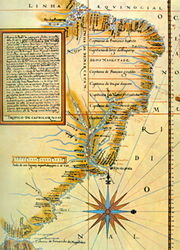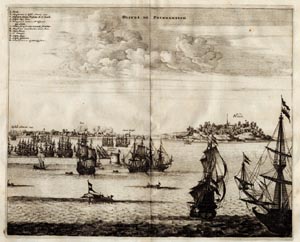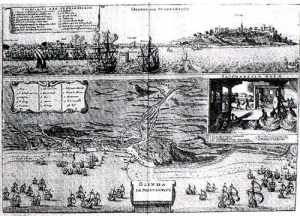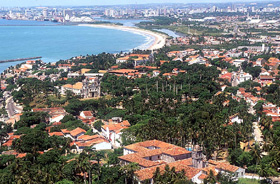|
|
History of Olinda
« More information about Olinda
«Recife
«Pernambuco
History of Brazil starts officially on April 22nd 1500, when Portuguese navigator Pedro Álvares Cabral reached the coast of Bahia.
Portugal didn't have financial or human resources to settle the new lands; at the same time, Portugal had to defend the new lands from the incursions of invaders.
In 1534, the Portuguese King created the Hereditary Captaincies; each of the Captains was given a large plot of land, which they should settle at their own expenses. Because of the many difficulties (long distances, lack of support), most captaincies never prospered.
One of the few captaincies which prospered was Pernambuco, in the northern coast. The Captain was Duarte Coelho, who arrived in Pernambuco on March 9th 1535.

Brazil divided in Captaincies
Looking for a site to establish himself, Duarte Coelho reached a region with hills, then inhabited by the indians. The area afforded a long distance viewing of the sea, and was easy to defend; the land was fertile, with plenty of water; there was a line of natural reefs which formed a natural port, necessary for the exportation of goods.
Even if these factors were not enough to convince Duarte Coelho to settle in the area, there was another one: the beautiness of the place; History goes that, when he first viewed the sea from the top of Olinda, Coelho exclaimed: "Oh linda situação para construir uma vila" (What a beautiful place to construct a village". From the beginning, the name of the place was given.
The date when Coelho reached Olinda is uncertain. It is known that on March 12th 1537 the settlement had grown so much that it was elevated to the status of village; Olinda celebrates its anniversary on March 12th.
Olinda grew so quickly thanks to two factors. First, the massive exploration of pau-brazil (brazilwood), a kind of tree used for dying fabrics in the 16th century; pau-brazil was so abundant in Brazil that it eventually gave name to the country.
When pau-brazil exhausted, Duarte Coelho introduced the plantation of sugar cane. This kind of sugar was much more appreciated than the sugar beet used by then in Europe. The cane adapted very well to the soil and climate of Pernambuco.
From 1530s to 1630s, many cane farms established all over Pernambuco. Most land lords lived in Olinda, which was the administrative capital of the Captaincy, and one of the main commercial centers of the colony.
Also during that period, two groups started to arrive in Olinda: the black slaves and the European religious. Black slaves from Africa was the work force which moved the cane farms; indians were used in the beginning, to exploit brazil-wood, but the Portuguese Crown had huge profits with the commerce of slaves, and stimulated their usage in the farms. To doutrinate indians and blacks, the Catholic Church, who was facing the Reformists in Europe but still had a strong influence in Portugal and Spain, promoted missions by several orders: carmelites (the first one arrived in 1580), jesuites (1583), franciscans (1585) and benedicts (1586); most of the Historic Churches of Olinda date back to that epoch.

Dutch fleet attacks Olinda
The sugar cane, cause of Olinda fortune, was also cause of misfortune.
Until 1580, Portugal and Holland had a commercial agreement; Portugal would produce the sugar, and the Dutch would use their commercial network to distribute it across Europe (a good part of the investments in Brazilian farms had also been financed by Dutch banks).
In 1580, the King of Portugal died leaving no heirs, and the kingdoms of Portugal and Spain merged; Spain and Holland didn't have good relations, and the Dutch lost their distribution monopoly.
In 1621, the Dutch created the West Indian Company, supposedly a trading company, but aiming at conquering new territories.
In 1624, a fleet of the West Indian Company attacks and dominates Salvador, which was then the capital of Brazil; the Spanish Crown sends their Army, and the Dutch are defeated in 1625.
In 1630, the Dutch invade Olinda and dominate Pernambuco. This time, the dominance lasted from 1630 to 1654; at the peak of their presence in Brazil, the Dutch controlled from São Cristóvão, in the State of Sergipe, to Fortaleza, in Ceará (this means that the current States of Ceará, Rio Grande do Norte, Paraíba, Pernambuco, Alagoas and Sergipe were under control of the Dutch).
The Dutch promoted radical changes in the way that Pernambuco was administered, particulary between 1637 and 1644, when the administrator was Mauricio de Nassau.

Olinda map, 1657.
By Jan Jansson, Theatrum Urbium
Instead of the hills of Olinda, the Dutch decided to establish home in the flat lands of Recife, which resembled Amsterdam. In 1631, the Dutch ordered that housing material were removed from Olinda and sent to Recife, to build new houses; after that, the Dutch burned Olinda to ground.
The exportation of sugar, which was spread over a few ports, including Itamaracá and Goiana, were concentrated on Recife; in a few years, thanks to the business around the port, Recife had become the largest city in Pernambuco. Maurício de Nassau, a man of culture, called Recife as New Amsterdam; he brought architects, urbanists, engineers, to reurbanize the city. Famous artists like Franz Post and Albert Eckhout portrayed for the first time the life in Brazil. Nassau was tolerant towards religion, and allowed the Jews to come to Recife and open the first synagogue in the Americas.
Even after the Dutch were expelled, in 1654, Olinda (which had to be rebuilt from ground) could never regain the importance taken by Recife. The Dutch learned the techniches of cultivating cane, and soon their colonies in the Antilles were outproducing Pernambuco.
The power of the farm lords had diminished, replaced by the trademen of Recife. Recife became one of the main commercial and intellectual centers of Brazil, status maintained until today.

Olinda today.
Recife is in the background
Recife grew to the North, towards Olinda, sooner than growing South (until the 1950s, Boa Viagem, the famous beach in the south of Recife, was a distant area, separated from downtown by the River Capibaribe; only after a bridge was built did Boa Viagem grow quickly); the urban areas of Recife and Olinda soon were merged.
Early in the 20th century, rail roads were laid to connect the cities. Many people moved from Recife to Olinda. Over the decades, it naturally occurred that business oriented people preferred Recife, whereas leisure and culture oriented people moved to Olinda.
In 1982, the historic downtown of Olinda was declared by UNESCO as Historical and Cultural Heritage of Mankind.
In the opening of the 21st Century, Recife and their skyscraped line was one the main economic metropolis of Brazil, and Olinda and their historic houses was declared the first Brazilian Capital of Culture.
| |



